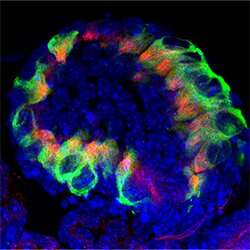Lab-grown cochlear organoids enable screening for hair cell–inducing drugs

New research published in Stem Cell Reports found that organoid culture-based models for cochlear hair cell formation can be used to identify drugs that promote hair cell regeneration in a high throughput drug library screen.
Hair cells in the ear mediate the perception of sound. Consequently, when hair cells are destroyed or lost through exposure to loud sounds, certain chemicals, disease, or aging, partial or complete hearing loss is the consequence. According to WHO estimates, one in every 10 people worldwide will have disabling hearing loss by 2050.
Lost hair cells in mammals cannot be repaired or replaced, but intriguingly hair cells in other species like fish and birds have the potential to regenerate. The reasons for those differences are not fully understood, but it means that hair cell regeneration in humans may be possible under the right conditions.
To identify those conditions, Guoqiang Wan and colleagues from Nanjing University, China, generated cultures of inner ear-like structures, so-called cochlear organoids, from immature cochlear tissue of neonatal mice. Over time, these cochlear organoids multiplied and grew hair cells in the lab. The study, recently published in Stem Cell Reports, used these cochlear organoids to screen a collection of over one thousand FDA-approved drugs for substances stimulating hair cell formation. One of the most potent substances, an anti-cancer drug called Regorafenib, promoted hair cell formation in the lab-grown cochlear organoids. Notably, this compound also promoted hair cell formation in mouse cochlear tissues. Remarkably, hair cells were even regenerated in mouse cochlear tissues after having been destroyed by chemical exposure.
This work sets the stage for high throughput screening approaches to identity stimulators of hair cell regeneration in mammals as a potential treatment for hearing loss. Before this can be applied in patients, additional research is needed to address safety and to determine if the identified drugs can induce hair cells in the human cochleas.
More information: High throughput screening on cochlear organoids identifies VEGFR-MEK-TGFB1 signaling promoting hair cell reprogramming, Stem Cell Reports (2021). DOI: 10.1016/j.stemcr.2021.08.010 , www.cell.com/stem-cell-reports … 2213-6711(21)00428-8
Journal information: Stem Cell Reports
Provided by International Society for Stem Cell Research



















